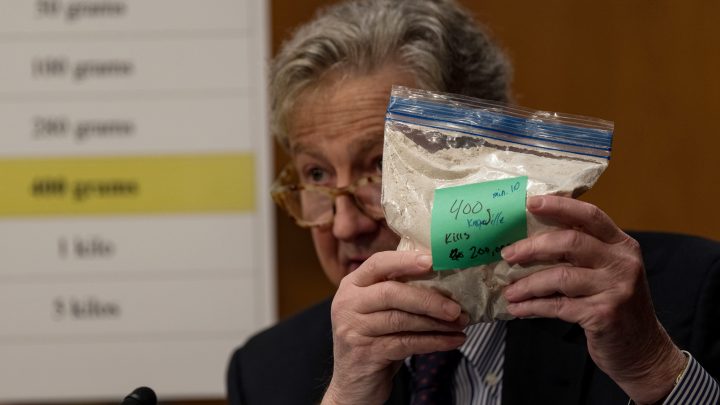
As opioid settlement funds hit state coffers, a marketing blitz begins
As opioid settlement funds hit state coffers, a marketing blitz begins

Since the opioid epidemic began, hundreds of thousands have died from overdoses. Now, the companies accused of flooding communities with these painkillers are paying up. But as state and local governments begin to receive the first parts of that $50 billion in settlement money, legislators are seeing a great deal of interest in how that money is spent.
According to reporting from KFF Health News, officials who are handling this money have been inundated with marketing pitches from private, public, nonprofit and for-profit entities, all intent on getting a slice of the settlement payout.
Aneri Pattani, a senior correspondent with KFF Health News, joined Marketplace’s Kimberly Adams to talk about how the opioid settlement funds can, and perhaps should, be used.
Kimberly Adams: Let’s say that I’m a state official involved in distributing some of this money. What does my email inbox look like these days?
Aneri Pattani: It is full of people asking you to have a brief call, to meet for a short time, so they can tell you about their new product and how it relates to the opioid crisis and how it’s going to prevent addiction, or save lives, or help them turn around the tide of this epidemic. There’s just so much marketing going at these state and local officials who are in charge of the money right now.
Adams: And not just in email. I saw in your piece that they’re putting advertisements in, you know, like, newsletters and magazines targeted at county, state and county officials.
Pattani: Yeah, they’re going wherever their audience is. So they’re trying to do whatever they can to kind of get on folks’ radar and say, “Here’s an opportunity. You have this money coming, you could spend it on our product.”
Adams: Give me a couple of examples of the sort of products that jumped out to you that were being advertised in this way.
Pattani: So, one that really caught my attention is a product called a BolaWrap. It is a device for law enforcement officers. You press a button and it shoots out this Kevlar tether that can sort of fly through the air and wrap around someone’s body as a way to detain them. And they have sent out, we’ve obtained through public records requests and other means, emails to different police departments with sort of like a two-page Q&A document about how the opioid settlement funds can be used to buy this product. A lot of people, when I just describe the device to them, have said to me, “How does that address the opioid crisis?” And I think the marketing is not that different whenever governments have pots of money, there are companies that are asking them to put it towards their products. I think why people have a particularly bad reaction to this sometimes, particularly individuals who have lost loved ones to the opioid crisis, they feel like the opioid crisis was created by corporations that got greedy, that got, you know, so focused on the money and profits that they lost sight of being responsible or what their products were doing. And so there’s a particular concern just with this idea of, we got this money because of corporate wrongdoing. Should it be going to corporations again?
Adams: Are there rules in place for how this money can be used? Or at least guidance?
Pattani: Yes. So most of the settlement agreements — I say “most” because there are different agreements with different companies — but the majority of them say that at least 85% of the money a state receives has to be used for “opioid remediation,” which is basically a fancy way of saying things related to addiction and overdoses. So preventing addiction, helping with treatment, recovery. Of course, there is some interpretability with that. And, you know, that’s where we’re seeing some confusion and contention, and it’s really an open question depending on how each locality interprets this guidance of what qualifies as opioid remediation.
Adams: You say in your piece that there’s a precedent for this moment with the big tobacco settlements. What do you think we can learn from how that money was distributed and spent?
Pattani: The tobacco settlement is a cautionary tale. Most of that money that came from cigarette companies did not go to antismoking efforts. In fact, there are statistics that show about 3% of the annual payouts a year go to antismoking or smoking-prevention work. The rest of it has been used on anything and everything you can imagine. And it’s not to say it’s all bad, but it’s not necessarily what it was intended for. There has been money that’s gone to building new schools and paving roads and corporate tax breaks. And in the case of North Carolina [and] South Carolina, subsidizing tobacco farmers. That history a lot of people bring up because they don’t want to see the same thing happen with the opioid settlement funds. This money is here to address the addiction crisis, which is ongoing. We have record numbers of people dying overdose deaths in the past several years in this country. So I think people really want to make sure the money is going to address the problem that is so urgent and so immediate.
There’s a lot happening in the world. Through it all, Marketplace is here for you.
You rely on Marketplace to break down the world’s events and tell you how it affects you in a fact-based, approachable way. We rely on your financial support to keep making that possible.
Your donation today powers the independent journalism that you rely on. For just $5/month, you can help sustain Marketplace so we can keep reporting on the things that matter to you.

















